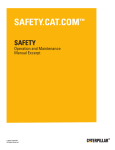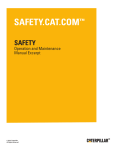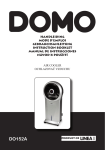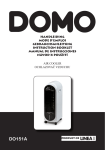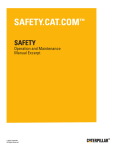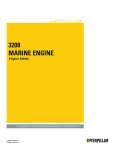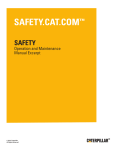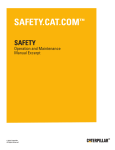Download SAFETY - Caterpillar
Transcript
SAFETY Operation and Maintenance Manual Excerpt © 2010 Caterpillar All Rights Reserved ® ® SEBU7077-01 November 1998 Operation and Maintenance Manual D3C Series III, D4C Series III and D5C Series III HYSTAT Track-Type Tractors 4KS1-Up (Machine) 4LS1-Up (Machine) 4TS1-Up (Machine) 5GS1-Up (Machine) 5HS1-Up (Machine) 6BS1-Up (Machine) 6CS1-Up (Machine) 7PS1-Up (Machine) 8CS1-Up (Machine) i00056692 Important Safety Information Most accidents that involve product operation, maintenance and repair are caused by failure to observe basic safety rules or precautions. An accident can often be avoided by recognizing potentially hazardous situations before an accident occurs. A person must be alert to potential hazards. This person should also have the necessary training, skills and tools to perform these functions properly. Improper operation, lubrication, maintenance or repair of this product can be dangerous and could result in injury or death. Do not operate or perform any lubrication, maintenance or repair on this product, until you have read and understood the operation, lubrication, maintenance and repair information. Safety precautions and warnings are provided in this manual and on the product. If these hazard warnings are not heeded, bodily injury or death could occur to you or to other persons. The hazards are identified by the “Safety Alert Symbol” and followed by a “Signal Word” such as “WARNING” as shown below. The meaning of this safety alert symbol is as follows: Attention! Become Alert! Your Safety is Involved. The message that appears under the warning explains the hazard and can be either written or pictorially presented. Operations that may cause product damage are identified by “NOTICE” labels on the product and in this publication. Caterpillar cannot anticipate every possible circumstance that might involve a potential hazard. The warnings in this publication and on the product are, therefore, not all inclusive. If a tool, procedure, work method or operating technique that is not specifically recommended by Caterpillar is used, you must satisfy yourself that it is safe for you and for others. You should also ensure that the product will not be damaged or be made unsafe by the operation, lubrication, maintenance or repair procedures that you choose. The information, specifications, and illustrations in this publication are on the basis of information that was available at the time that the publication was written. The specifications, torques, pressures, measurements, adjustments, illustrations, and other items can change at any time. These changes can affect the service that is given to the product. Obtain the complete and most current information before you start any job. Caterpillar dealers have the most current information available. For a list of the most current publication form numbers available, see the Service Manual Contents Microfiche, REG1139F. 6 Safety Section Warning Signs and Labels Do Not Operate Safety Section i00126754 Warning Signs and Labels SMCS Code: 7000; 7405 There are several specific warning signs on this machine. The exact location of the hazards and the description of the hazards are reviewed in this section. Please become familiarized with all warning signs. Make sure that all of the warning signs are legible. Clean the warning signs or replace the warning signs if you cannot read the words. Replace the illustrations if the illustrations are not legible. When you clean the warning signs, use a cloth, water and soap. Do not use solvent, gasoline, or other harsh chemicals to clean the safety signs. Solvents, gasoline, or harsh chemicals could loosen the adhesive that secures the warning sign. Loose adhesive will allow the warning sign to fall. Illustration 2 g00111634 This warning label is located in the cab under the gauge panel. Replace any safety sign that is damaged, or missing. If a safety sign is attached to a part that is replaced, install a safety sign on the replacement part. Any Caterpillar dealer can provide new safety signs. g00111635 Do not operate or work on this machine unless you have read and understand the instructions and warnings in the Operation and Maintenance Manuals. Failure to follow the instructions or heed the warnings could result in injury or death. Contact your Caterpillar dealer for replacement manuals. Proper care is your responsibility. 7 Safety Section Warning Signs and Labels ROPS Illustration 3 Pressurized System g00118125 This warning label is located on the outside of the cab on the left front side. Illustration 4 g00118126 Open the access panel on the top of the hood. The warning label is located on the radiator on the left side of the machine. g00111632 Structural damage, an overturn, modification, alteration, or improper repair can impair this structure’s protection capability thereby voiding this certification. Do not weld on or drill holes in the structure. Consult a Caterpillar dealer to determine this structure’s limitations without voiding its certification. g00102174 Pressurized system: Hot coolant can cause serious burn. To open cap, stop engine, wait until radiator is cool. Then loosen cap slowly to relieve the pressure. 8 Safety Section Warning Signs and Labels High Pressure Cylinder (Cover) Illustration 5 g00122904 This warning label is located on the top of the adjustment valve cover. High Pressure Cylinder (Valve) Illustration 6 g00122908 This warning label is located on the top of the track adjustment valve. g00122899 HIGH PRESSURE CYLINDER Do not remove any parts until all pressure has been relieved to avoid possible personal injury. Relieve pressure by opening relief valve one turn maximum. See maintenance guide for track adjustment procedure. TRACK ADJUSTMENT PROCEDURE 1. Adjust idler forward to tight track position. 2. Open relief valve one turn maximum. Adjust idler back 10 mm (.39 inch). Close relief valve. g00122900 HIGH PRESSURE CYLINDER Do not remove any parts until all pressure has been relieved to avoid possible personal injury. Relieve pressure by opening relief valve one turn maximum. See maintenance guide for track adjustment procedure. TRACK ADJUSTMENT PROCEDURE 1. Adjust idler forward to tight track position. 2. Open relief valve one turn maximum. Adjust idler back 10 mm (.39 inch). Close relief valve. 9 Safety Section Warning Signs and Labels Batteries Illustration 7 Battery g00122922 Open the access door to the battery compartment. The warning label is located on the inside of the access door. Illustration 8 g00122940 The warning label is located on the battery. g00109769 DANGER/POISON Shield eyes, Exposive gases. Can cause blindness or injury. No sparks, flames or smoking. Sulfuric Acid can cause blindness or severe burns. g00122920 Improper jumper cable connections can cause explosion resulting in personal injury. Batteries may be located in separate compartments. When using jumper cables, always connect positive (+) cable to positive (+) terminal of battery connected to starter solenoid and negative (−) cable from external source to starter negative (−) terminal (if machine not equipped with starter negative terminal, connect to engine block.) Follow procedure in the operation manual. FLUSH EYES IMMEDIATELY WITH WATER. Get medical help fast. Keep out of reach of chrildren. Contains sulfuric acid. For medical emergency in USA or Canada contact: 800-458-5924, other countries contact: 303-893-1322. 10 Safety Section General Hazard Information Ether Before you service the machine or before you repair the machine, attach a “Do Not Operate” warning tag or a similar warning tag to the start switch or to the controls. These warning tags Special Instruction, SEHS7332 are available from your Caterpillar dealer. Know the width of your equipment in order to maintain proper clearance near fences, boundary obstacles, etc. Wear a hard hat, protective glasses and other protective equipment in order to accommodate job conditions. Illustration 9 g00111633 This warning label is located on the air cleaner inside the engine compartment. Do not wear loose clothing or jewelry that can catch on controls or on other parts of the machine. Ensure that all protective guards and all covers are secured in place on the machine. Keep the machine free from foreign material. Check the deck, the walkways and the steps. Remove debris, oil, tools and other items. Secure all loose items that are not a part of the machine. Secure lunch boxes, tools and other items. Know the appropriate work site hand signals. Also, know the personnel that are authorized to give the hand signals. Accept signals from one person only. g00103679 Do not spray ether into the intake. i00160119 General Hazard Information Do not smoke when you service an air conditioner. Also, do not smoke if refrigerant gas may be present. Inhaling the fumes that are emitted from a flame that contacts air conditioner refrigerant can cause bodily harm or death. Inhaling gas from air conditioner refrigerant through a lighted cigarette can cause bodily harm or death. Never put maintenance fluids into glass containers. Drain all liquids into a suitable container. When you discard liquids, obey all local regulations. SMCS Code: 7000 Use all cleaning solutions with care. Report all necessary repairs. Do not allow unauthorized personnel on the machine. Unless you are instructed otherwise, perform the maintenance with the following conditions: • The machine is parked on level ground. • The attachment controls are in HOLD position. Illustration 10 g00037327 • The direction/speed control lever is in NEUTRAL position. 11 Safety Section Crushing Prevention and Cutting Prevention • The transmission lock lever is in the LOCKED position. • Lower the blade until the blade exerts a slight downward pressure onto the ground. • The engine is stopped. • The engine start switch in the OFF position and the key is removed. Use caution. Avoid inhaling dust that might be generated when you handle components that contain asbestos fibers. If this dust is inhaled, it can be hazardous to your health. The components that may contain asbestos fibers are brake pads, brake bands, lining material, clutch plates, and some gaskets. The asbestos that is used in these components is usually bound in a resin or sealed in some way. Normal handling is not hazardous, unless airborne dust that contains asbestos is generated. • The disconnect switch is in the OFF position and If dust which can contain asbestos is present, there are several guidelines that should be followed: Pressure Air • Never use compressed air for cleaning. the key is removed. Pressure air can cause personal injury. When pressure air is used for cleaning, wear a protective face shield, protective clothing and protective shoes. The maximum air pressure must be below 205 kPa (30 psi) for cleaning purposes. Trapped Pressure Pressure can be trapped in a hydraulic system. Trapped pressure can cause sudden machine movement or attachment movement. Use caution if you disconnect hydraulic lines or fittings. High pressure oil that is released can cause a hose to whip. High pressure oil that is released can cause oil to spray. Fluid penetration can cause serious injury and possible death. Fluid Penetration When you check for a leak, use a board or cardboard. Leaking fluid that is under pressure can penetrate body tissue. Fluid penetration can cause serious injury and possible death. A pin hole leak can cause severe injury. If fluid is injected into your skin, you must obtain treatment immediately. Seek treatment from a doctor that is familiar with this type of injury. • Avoid sweeping materials that contain asbestos. • Also avoid grinding materials that contain asbestos. • Use a wet method in order to clean up asbestos materials. • You may also use a vacuum that is equipped with a highly efficient filter that cleans particulate air. • Use exhaust ventilation on permanent machining jobs. • Wear an approved respirator if there is no other way to control the dust. • Comply with applicable rules and regulations for the work place. In the USA, use Occupational Safety and Health Administration requirements. These OSHA requirements can be found in “29 CFR 1910.1001”. • Obey environmental rules for the disposal of asbestos and obey environmental regulations for the disposal of asbestos. • Stay away from areas that might have asbestos particles in the air. i00128583 Asbestos Information Caterpillar equipment and replacement parts that are shipped from Caterpillar are asbestos free. Caterpillar recommends the use of only genuine Caterpillar replacement parts. If any replacement parts that contain asbestos are used, the following guidelines should be used in handling these parts and asbestos debris. Crushing Prevention and Cutting Prevention SMCS Code: 7000 Support the equipment properly when you work beneath the equipment. Do not depend on the hydraulic cylinders to hold up the equipment. An attachment can fall if a control is moved, or if a hydraulic line breaks. 12 Safety Section Burn Prevention Unless you are instructed otherwise, never attempt adjustments while the machine is moving. Also, never attempt adjustments while the engine is running. Burn Prevention Whenever there are attachment linkages, the clearance in the linkage area will increase or the clearance in the linkage area will decrease with movement of the attachment. Coolant Stay clear of all rotating and moving parts. Keep objects away from moving fan blades. The fan blade will throw objects or cut objects. Do not use a kinked wire rope cable or a frayed wire rope cable. Wear gloves when you handle wire rope cable. When you strike a retainer pin with force, the retainer pin can fly out. The loose retainer pin can injure personnel. Make sure that the area is clear of people when you strike a retainer pin. i00057866 SMCS Code: 7000 At operating temperature, the engine coolant is hot and the engine coolant is under pressure. The radiator and all lines to heaters or to the engine contain hot coolant or steam. Any contact can cause severe burns. Steam can cause personal injury. Only check the coolant level after the engine has been stopped. Make sure that the radiator filler cap is cool. In order to remove the radiator cap with the bare hand, the radiator cap must be cool. In order to relieve pressure, remove the radiator filler cap slowly. In order to avoid injury to your eyes, Wear protective glasses when you strike a retainer pin. Cooling system additive contains alkali. Alkali can cause personal injury. Do not allow alkali to contact the skin, the eyes and the mouth. Chips or other debris can fly off objects when you strike the objects. Make sure that no one can be injured by flying debris before striking any object. Allow cooling system components to cool before you drain the cooling system. Rollover Protective Structure (ROPS) or Falling Objects Protective Structure (FOPS) These guards are located above the operator’s compartment and these guards are secured to the machine. To avoid the possible weakening of the ROPS or FOPS, consult a Caterpillar dealer before you alter the guards. Do not alter the structure by welding, cutting, adding weight, or drilling holes into the structure. Any alteration that is not specifically authorized by Caterpillar invalidates the Caterpillar certification for the ROPS and the FOPS. The protection that is offered by the ROPS or by the FOPS will be impaired if the ROPS or the FOPS has structural damage. Damage to the structure can be caused by an overturn, falling objects, etc. Do not mount fire extinguishers, first aid kits, lights, or other items to the ROPS structure or to the FOPS. Welding brackets or drilling holes in the ROPS or in the FOPS can weaken the structures. See your Caterpillar dealer for mounting guidelines. Oils Hot oil and hot components can cause personal injury. Do not allow hot oil to contact the skin. Also do not allow hot components to contact the skin. At operating temperature, the hydraulic tank is hot. Remove the hydraulic tank filler cap only after the engine has been stopped. The filler cap must be cool enough to touch. Remove the hydraulic tank filler cap slowly in order to relieve pressure. Relieve all pressure in the air system, in the oil system, in the fuel system or in the cooling system. Relieve the pressure before any lines, any fittings or any related items are disconnected or removed. Batteries Batteries give off flammable fumes which can explode. Do not smoke when you observe the battery electrolyte levels. Electrolyte is an acid. Electrolyte can cause personal injury. Do not allow electrolyte to contact the skin or the eyes. 13 Safety Section Fire Prevention and Explosion Prevention Always wear protective glasses when you work with batteries. i01029832 Fire Prevention and Explosion Prevention SMCS Code: 7000 Do not expose the machine to flames or to brush that is burning. Shields protect hot exhaust components from oil spray or fuel spray. Make sure that the shields are installed correctly in case a line, a tube, or a seal fails. Ether All fuels, most lubricants, and some coolant mixtures are flammable. Do not spray ether into an engine when you use thermal starting aid to start the engine. Fuel that is leaking, fuel that is spilled onto hot surfaces, and fuel that is spilled onto electrical components can cause a fire. Ether is poisonous and flammable. Inhaling ether vapors can cause personal injury. Do not allow ether to contact your skin repeatedly. Use ether only in well ventilated areas. Do not smoke while you replace ether cylinders. Use ether carefully to avoid fires. Do not store ether cylinders in living areas or in the operator’s compartment. Do not smoke while you refuel or while you are in a refueling area. Do not smoke in battery charging areas or in areas that are used to store flammable material. Batteries can be installed in separate compartments. When you use jump start cables, always connect the positive “(+)” cable to the positive “(+)” terminal of the battery that is connected to the starter solenoid. Connect the negative “(−)” cable from the external source to the negative “(−)” terminal of the starter. Note: If the starter is not equipped with a negative “(−)” terminal, connect the cable to the engine block. See the Operation Section of this manual for specific starting instructions. Clean all electrical connections and tighten all electrical connections. Check the electrical wires daily for loose wires or for frayed wires. Tighten all loose wires before you operate the machine. Repair all frayed wires before you operate the machine. Store all fuels and lubricants in properly marked containers and away from all unauthorized persons. Store all oily rags or other flammable material in a protective container. Do not weld pipes that contain flammable fluids or tubes that contain flammable fluids. Do not flame cut pipes that contain flammable fluids or tubes that contain flammable fluids. Clean the pipes or tubes thoroughly with nonflammable solvent before you weld the pipes or tubes or you flame cut the pipes or tubes. Do not store ether cylinders in direct sunlight or at temperatures above 40C (102F). Discard ether cylinders in an approved place. Do not puncture ether cylinders. Do not burn ether cylinders. Keep ether cylinders out of the reach of unauthorized personnel. Lines, Tubes and Hoses Do not bend high pressure lines. Do not strike high pressure lines. Do not install bent lines, bent tubes, or bent hoses. Do not install damaged lines, damaged tubes, or damaged hoses. Repair loose lines, loose tubes, and loose hoses. Repair damaged lines, damaged tubes, and damaged hoses. Leaks can cause fires. See your Caterpillar dealer for repair or for replacement parts. Check lines, tubes and hoses carefully. Do not use your bare hand to check for leaks. Use a board or cardboard to check for leaks. See Operation and Maintenance Manual, “Fluid Penetration” for more details. Tighten all connections to the recommended torque. Replace the parts if any of the following conditions are present: • The end fittings are damaged or leaking. • The outer covering is chafed or cut. • The wire shield is exposed. • The outer covering is ballooning locally. Remove all flammable materials (fuel, oil, debris, etc) before the flammable materials accumulate on the machine. • The flexible part of the hose is kinked or crushed. • The armoring is embedded in the outer cover. 14 Safety Section Electrical Storm Injury Prevention • The end fittings are displaced. • Maintain a three-point contact with the steps and handholds. Make sure that all clamps, guards, and heat shields are installed correctly in order to prevent vibration and excessive heat. i00061446 Electrical Storm Injury Prevention Note: Three-point contact can be two feet and one hand. Three-point contact can also be one foot and two hands. • Do not get on a moving machine. Do not get off a moving machine. • Never jump off the machine. SMCS Code: 7000 • Do not try to get on the machine if you are When lightning is striking in the near vicinity of the machine, the operator should never attempt the following procedures: carrying tools or supplies. Do not try to get off the machine if you are carrying tools or supplies. Use a hand line to pull equipment onto the platform. • Do not use any controls as handholds when you • Mount the machine. enter the operator’s compartment or when you exit the operator’s compartment. • Dismount the machine. If you are in the operator’s station during an electrical storm, stay in the operator’s station. If you are on the ground during an electrical storm, stay away from the vicinity of the machine during an electrical storm. Alternate Exit Machines that are equipped with cabs have alternate exits. For additional information, see Operation and Maintenance Manual, “Alternate Exit”. i00057874 Mounting and Dismounting SMCS Code: 7000 i00771840 Before Starting Engine SMCS Code: 1000; 7000 • Get on the machine only at locations that are equipped with steps and/or handholds. Get off the machine only at locations that are equipped with steps and/or handholds. • Before you get on the machine, clean the steps and the handholds. Inspect the stairs and the handholds. Make all necessary repairs. Start the engine only from the operator compartment. Never short across the starter terminals or across the batteries. Shorting could damage the electrical system by bypassing the engine neutral start system. Inspect the condition of the seat belt and of the mounting hardware. Replace any parts that are worn or damaged. Regardless of appearance, replace the seat belt after three years of use. Do not use a seat belt extension on a retractable seat belt. Adjust the seat so that full pedal travel can be achieved with the operator’s back against the back of the seat. Make sure that the machine is equipped with a lighting system that is adequate for the job conditions. Make sure that all machine lights are working properly. Illustration 11 g00037367 • Face the machine whenever you get on the machine and whenever you get off the machine. Before you start the engine and before you move the machine, make sure that no one is underneath the machine, around the machine, or on the machine. Make sure that the area is free of personnel. 15 Safety Section Engine Starting i01029143 Engine Starting SMCS Code: 1000; 7000 If a warning tag is attached to the start switch or to the controls, do not start the engine. Also, do not move any controls. Move all hydraulic controls to the HOLD position before you start the engine. Place the Speed Hold Control Lever in the OFF position (if equipped). Engage the transmission lock lever. Diesel engine exhaust contains products of combustion which can be harmful to your health. Always start the engine in a well ventilated area. Always operate the engine in a well ventilated area. If you are in an enclosed area, vent the exhaust to the outside. i00037372 Before Operating Machine SMCS Code: 7000 Clear all personnel from the machine and from the area. Clear all obstacles from the path of the machine. Beware of hazards such as wires, ditches, etc. Make sure that all windows are clean. Secure the doors in the open position or in the shut position. Secure the windows in the open position or in the shut position. For the best vision of the area that is close to the machine, adjust the rear view mirrors (if equipped). Make sure that the machine horn, the backup alarm (if equipped) and all other warning devices are working properly. Fasten the seat belt securely. i00037373 Machine Operation SMCS Code: 7000 Only operate the machine while you are in a seat. The seat belt must be fastened while you operate the machine. Only operate the controls while the engine is running. While you operate the machine slowly in an open area, check for proper operation of all controls and all protective devices. Before you move the machine, you must be satisfied that no one will be endangered. Do not allow riders on the machine unless the machine has the following equipment: • additional seat • additional seat belt • Rollover Protective Structure (ROPS) Note any needed repairs during machine operation. Report any needed repairs. Carry attachments approximately 40 cm (15 inches) above ground level. Do not go close to the edge of a cliff, an excavation, or an overhang. If the machine begins to sideslip downward on a grade, immediately remove the load and turn the machine downhill. Avoid any conditions that can lead to tipping the machine. The machine can tip when you work on hills, on banks and on slopes. Also, the machine can tip when you cross ditches, ridges or other unexpected obstructions. Avoid operating the machine across the slope. When possible, operate the machine up the slopes and down the slopes. Maintain control of the machine. Do not overload the machine beyond the machine capacity. Be sure that the hitches and the towing devices are adequate. Only connect the trailing equipment to a drawbar or to a hitch. Never straddle a wire rope cable. Never allow other personnel to straddle a wire rope cable. Before you maneuver the machine, make sure that no personnel are between the machine and the trailing equipment. Block up the hitch of the trailing equipment in order to align the hitch with the drawbar. Maneuver the machine. Connect the machine to the trailing equipment. Know the maximum dimensions of your machine. Always keep the Rollover Protective Structure (ROPS) installed during machine operation. 16 Safety Section Machine Parking i01021463 Machine Parking i00135684 Sound Information and Vibration Information SMCS Code: 7000 Park on a level surface. If you must park on a grade, chock the machine. Move the direction/speed control lever to the NEUTRAL position in order to stop the machine. Move the speed hold control lever to the OFF position if your machine is equipped. Move the governor lever to the LOW IDLE position. Move the transmission lock lever to the LOCKED position. SMCS Code: 7000 Sound Level for Enclosed Cab The operator sound pressure level for this machine in the operator’s compartment is an average of 82 dB. This machine is equipped with a properly installed, properly maintained enclosed cab. The measurement was obtained on a static machine. To find the procedure for using the static machine and the conditions for using the static machine, see “ISO 6394” or “86/662/EEC”. Lower all attachments to the ground. Stop the engine. Turn the engine start switch key to OFF position and remove the key. Vibration Level Turn the key for the battery disconnect switch to the OFF position. Remove the key when you leave the machine for an extended period of time. Hands and Arms: The hands and the arms are exposed to a weighted root mean square acceleration that is less than 2.5 meters per second squared. When you turn the battery disconnect switch to the OFF position, you can avoid battery discharge due to the following causes: • battery short circuit Whole Torso: The whole torso is exposed to a weighted root mean square acceleration less than 0.5 meters per second squared. Measurements are obtained on a representative machine. Use the measuring procedure in the following standards: “ISO 2631/1, ISO 5349, and SAE J1166” . • current draw via some components • vandalism i00037806 Equipment Lowering with Engine Stopped SMCS Code: 7000 The operator must be satisfied that no one is endangered before lowering the attachments. Push the attachment control lever forward in order to lower the bulldozer blade. Release the control lever. The control lever will return to the HOLD position. The ripper can be lowered by moving the ripper control lever to the right. Release the control lever. The control lever will return to the HOLD position.














